Chemistry Holiday Magic Show Demonstrates That Science Can Be Both Magic...and Fun!
December 20, 2019
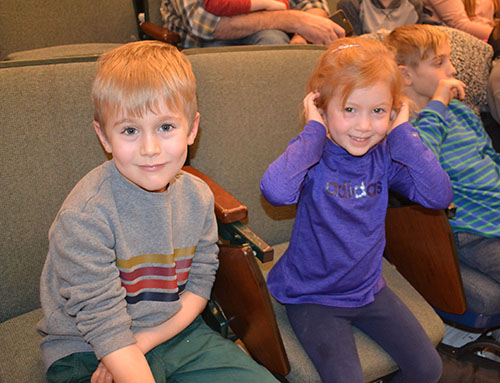
Two local youngsters enjoying Chemistry's 2019 edition of the Holiday Magic show.
“It’s not magic…it’s science! This was the chant Illinois Chemistry professor Don DeCoste had the audience repeat periodically during the Saturday, December 14th edition of Chemistry’s long-standing holiday tradition, the Holiday Magic Show. The plethora of pyrotechnic demos produced exothermic chemical reactions—heat, light, gas, smoke, and/or sound. The constant barrage of demos featuring fire, fireworks, explosions, and lots of liquid nitrogen had members of the audience laughing, clapping, sticking their fingers in their ears, evading soap suds explosions, and vowing to go home and try to figure out what made some of the reactions do what they did.
In its 15th year, the December 2019 season gave local folks three opportunities to experience the magic of chemistry with a Christmas flavor: Wednesday the 11th, plus Saturday and Sunday, the 14th and 15th. The show has gotten bigger and better over the years, too. For instance, instead of one liquid-nitrogen-and-dish-soap-produced Christmas tree…there were three. The number of folks helping out has increased too…evidently more and more of Chemistry’s teaching faculty have wanted to get in on the fun! Several chemistry students got involved too, having been promoted from just set-up and clean-up to starring roles during a couple of the demos.
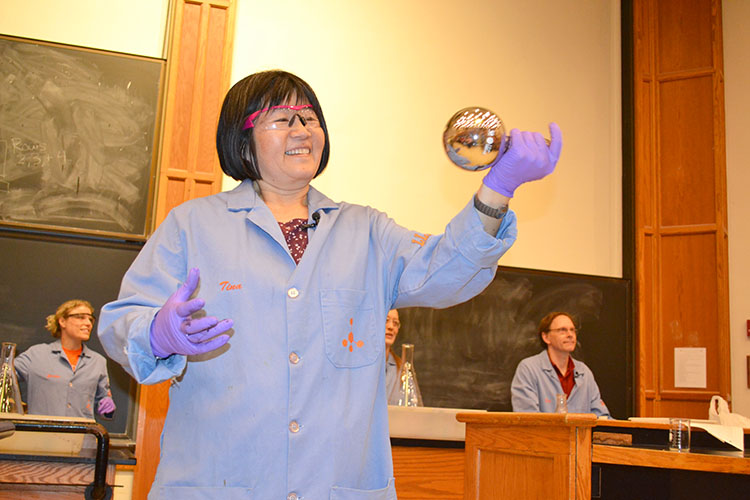
Tina Huang shows off the "silver bell" ornament she just made.
From the very beginning of the show, the Holiday Magic performers exposed the appreciative audience to the magic of chemistry. Garbed in "High-Energy Chemistry" lab coats, the team performed stunt after stunt, all exhibiting the show’s trademark formula: part magic show, part chemistry lesson, some slapstick comedy, and lots of fun—all related to the holiday theme and featuring appropriate holiday music in the background.
As usual, the show began with a rousing rendition of “We Wish You a Merry Christmas.” Half of the Chemistry folks had inhaled from Helium-filled balloons and sounded like the Three Chipmunks; the other half had inhaled some Sulfur Hexafluoride, and thus sounded like a bunch of Darth Vaders.
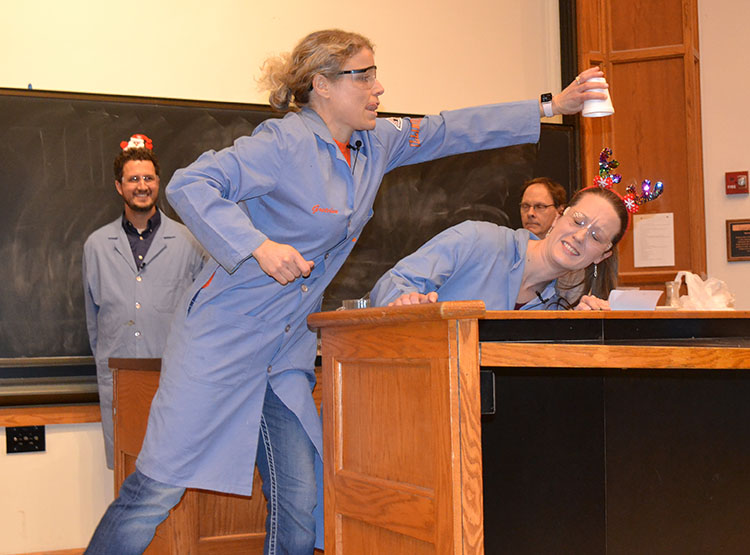
Gretchen Adams "pours" the contents of a cup over Elise McCarren's head during her "Shell Game" demo.
All of the demos exhibited the wonders of chemistry—Holiday Magic style. Snowmen were set ablaze. Gretchen Adams ignited some gas-filled balloons which went off with a big bang. Christian Ray electrified a pickle...and you could even say it glowed. The entire cast passed fire from hand to hand via gas-filled soapsuds. In Tina Huang’s “Silver Bells” segment, she and a few Chemistry students created “silver” ornaments for her tree.
In another of Gretchen Adams' demos, she did a "Shell Game" by pouring liquid into one of three cups, rapidly switching them around, then testing them by "pouring" them over the heads of several of her colleagues. As if by "magic" (or science?) although we had seen her pour liquid into one of the cups, it turned out that, during the testing phase (pouring them over her colleagues' heads), there was no liquid in any of them.
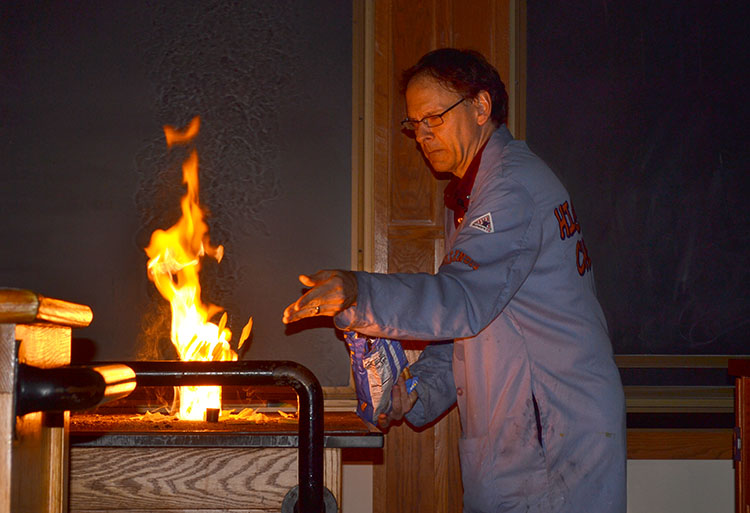
Don Decoste proves that sun chips are indeed made from the sun.
Don Decoste reasoned that since potato chips are made from potatoes, and corn chips are made from corn, then sun chips must made from the sun, then proceeded to test his theory…which, based on the bright sun-like glow that emanated, must have been accurate.
For the grand finale, the troupe pulled out all of the stops to produce a huge volcanic eruption of soap suds due in part to the liberal addition of dish soap. The soap suds explosion not only liberally doused the Director of General Chemistry, Christian Ray, with suds, but even reached some folks in the first couple of rows, who were offered paper towels after the demo.
It was clear that parents brought their kids to the show for the fun, holiday-themed entertainment. However, parents also hoped that their kids might pick up a little science too. For instance one local mother, Carrie Wells, admits that she brought her two kids to possibly get them interested in science. “I thought it would be a great way for the kids to experience science on a level that they could understand and appreciate while also being fun and engaging and, yes, so that they could learn about science.”
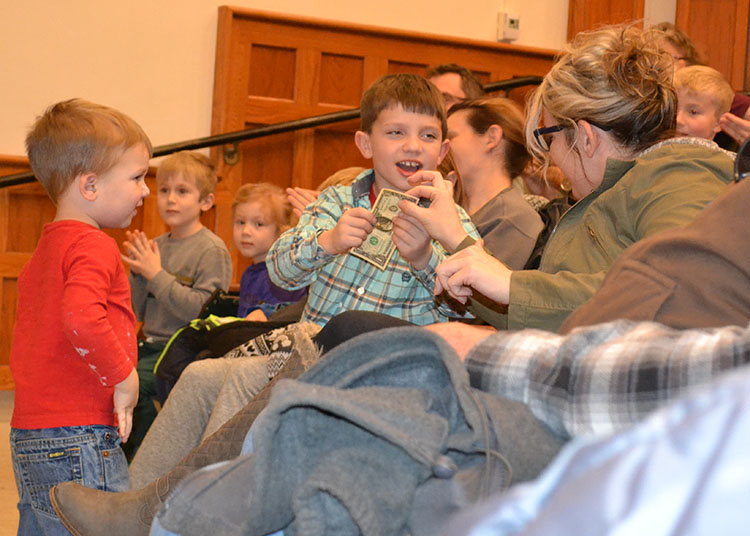
A young boy shows his mom the dollar bill he got which had been "on fire" but hadn't burned up.
Regarding specific demos during the show that might have piqued her kids’ interest in science? She indicates that during Decoste’s demo where he kept making the pitcher of liquid change from “water” to “Koolaid,” back to “water,” and then to “milk,” her kids were continually asking, “ ‘What is causing that to change?’ and ‘How is that happening?’ I think the general fascination with how that occurred and why that happened might have piqued their interest in chemistry in general.”
Her final take on the experience: “I think it was a great show. I'm very appreciative that they put it on free to the public so that lots of families can come and view it and allow their children to engage more with chemistry and realize that it's something that they also can do.”
Which activities impressed her kids? Her 8-year-old son, a third grader says his favorite part of the chemistry show was “the money one,” where “they set the money on fire, you know, and then it just faded and it wasn't burned up.”
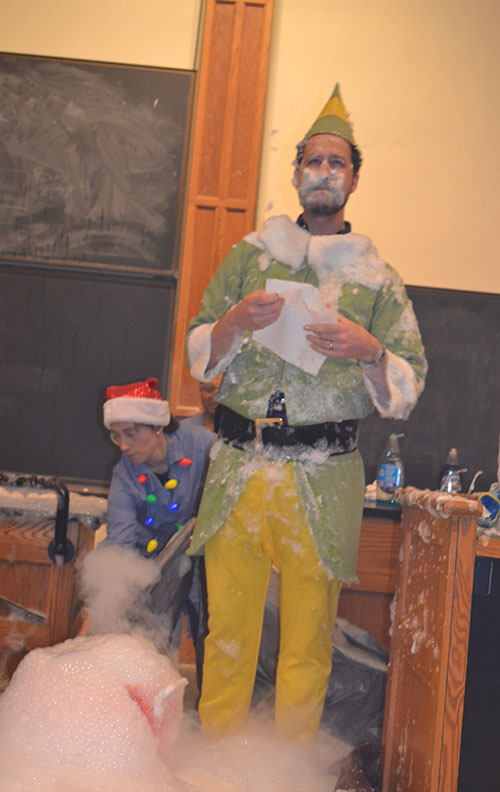
Christian Ray in the aftermath of the big finale, a soapsuds explosion precipitated by adding liquid nitrogen to a solution containing dish soap.
His little sister, a five-year-old kindergartener, particularly liked the grand finale: “I liked the last part where they put soap and water (and liquid nitrogen), and it splashed and that man was all covered with bubbles!”
Why do the Chemistry teaching faculty add another event (three, actually) to their probably busy end-of-the-semester schedules every year? According to José Andino, one reason is because of the camaraderie with his colleagues. “I think it brings us teaching faculty together,” he says. “We learn from each other, and there is a legacy that is nice to be part of." He also feels that he and his colleagues have a responsibility to communicate about Chemistry to the general public, acknowledging that: “To have kids and community members experience this fun side of chemistry is part of our social role as educators and scientists.”
Regarding the impact he believes the show has, Andino reports, “The kids will always remember the demos. For those who will pursue this type of work, they will eventually learn the science behind the demos that inspired them. For those that will not pursue chemistry, it is a fun memory to have from the university. Kids really enjoy this one hour of intense different fun. I congratulate the parents for bringing their kids out for the show.”
Story and photographs by Elizabeth Innes, Communications Specialist, I-STEM Education Initiative.
More: Chemistry, K-12 Outreach, REACT, 2019
For additional I-STEM articles about Chemistry outreach, see:
- Chemistry's Holiday Magic Show Does a Bang-Up Job Saying, “Merry Christmas!”
- REACT: Recruiting Tomorrow's Chemists Today Via Fun, Hands-On Activities
- Holiday Magic Show Helps Make the Season Merry and Bright
- REACT: Reaching and Educating Tomorrow's Chemists Today
- Campers Experience Ooey-Gooey Science
- Local Scouts Discover Chemistry is Fun!
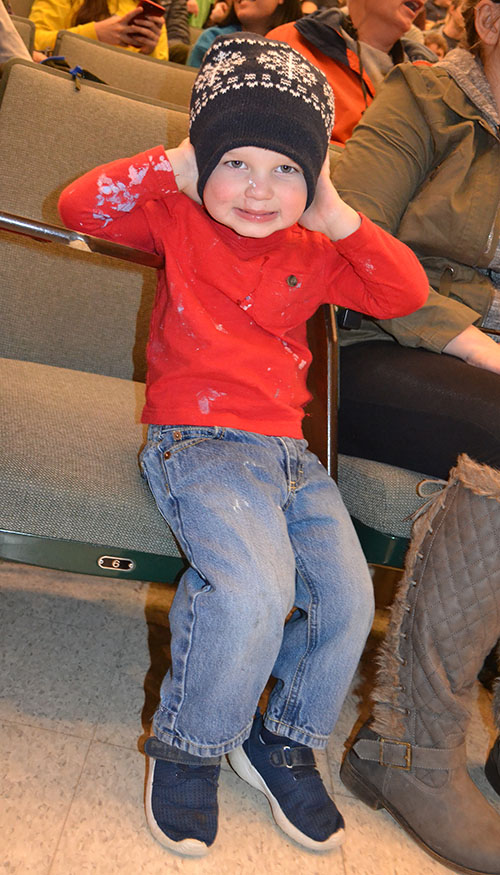
A young member of the audience prepares for the next demo, which he suspects will be a noisy one.
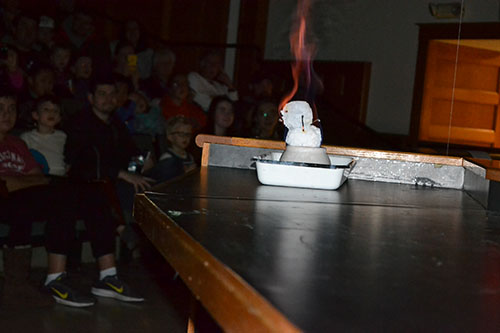
A flaming snowman.
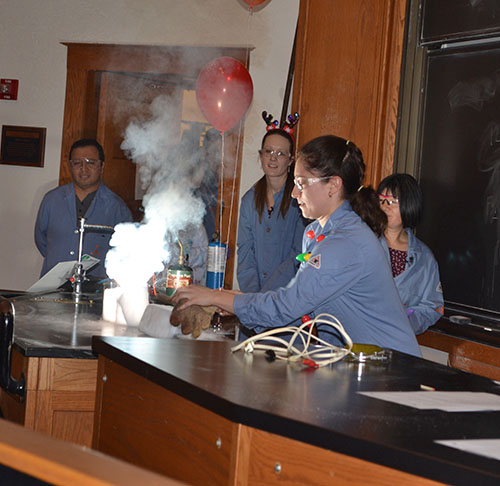
The exothermic chemical reaction in the demo done by Jordan Axelson produces a number of byproducts: heat, light, gas, smoke.
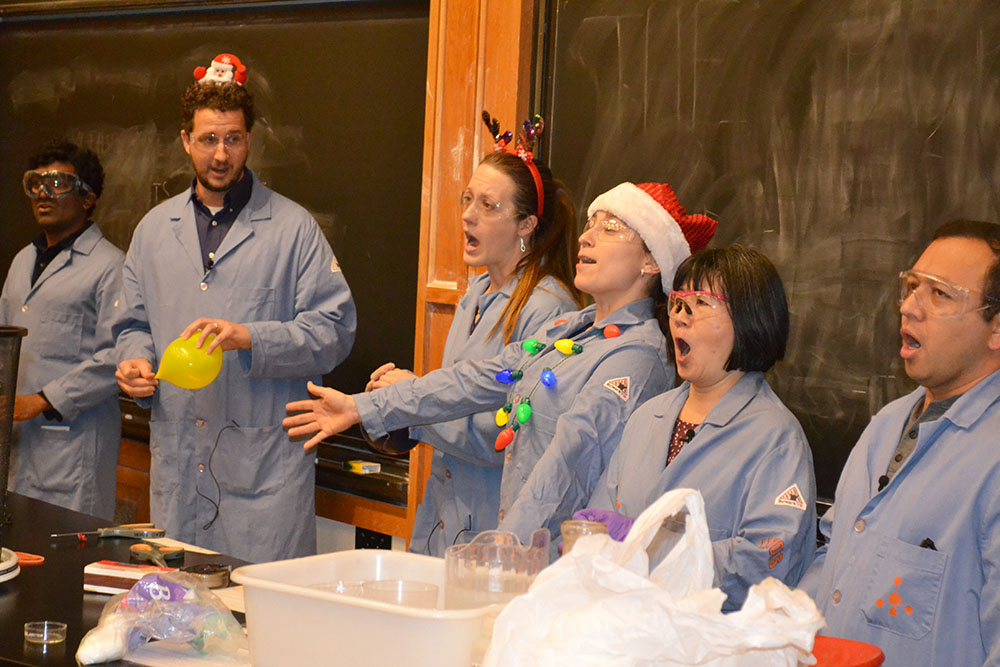
Several of Chemistry's teaching faculty, Mutha Gunasekera, Christian Ray, Elise McCarren, Jordan Axelson, Tina Huang, and José Andino perform the opening number for the 2019 Holiday Magic Show.













.jpg)
















